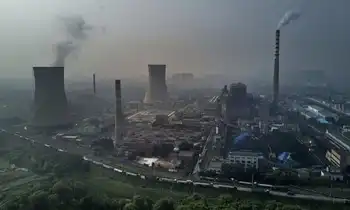First 'scrubber' at work on Marshall station emissions
Plumes of water vapor began pouring out of the plant's 350-foot smokestack Oct. 30, when the company went online with the first of three pollution scrubbers, said Duke spokesman Tom Williams.
"What people are seeing is the large stack, where there are three internal flues," Williams said. "The (steam) plume is much more visible and much cleaner" than past emissions.
The second and third scrubbers are expected to go online in the spring, he said.
In February 2004, Duke launched the $425 million project to help cut sulfur dioxide and other toxic emissions at the Marshall Steam Station, one of the state's larger coal-fired plants.
The scrubbers are part of a $1.5 billion plan by Duke to reduce emissions in some of the state's power plants and to comply with the N.C. Clean Smokestacks Act.
The act, passed in 2002, was intended to reduce nitrogen oxide emissions by 77 percent by 2009 and sulfur dioxide by 73 percent by 2013, according to Observer archives.
Coal-fired plants are among the biggest sources of air pollution in the Southeast. Sulfur dioxide, a byproduct of coal-firing, has been linked to respiratory illness, premature death, acid rain and haze.
The Marshall Steam Station opened in 1965 and today produces enough electricity to power 2 million homes.
At plants like the Marshall station, energy is created by heating water and creating steam inside a coal-fired boiler. Pressure from the steam spins turbines, which are connected to a generator to create electricity.
Before the scrubbers, the more-toxic emissions were released through four 280-feet stacks. Now, with the first of three scrubbers running, the cleaner emissions are rerouted through a flue inside the 350-foot stack and released in a plume of steam.
By spring 2007 the flues, Williams said, will run from the three scrubbers, mixing flue gas, the byproduct of burning coal, with a limestone and water mixture, through the smokestack. The chemical reaction scrubs the toxic gases, removing 95 percent or more of the sulfur dioxide and a significant amount of the mercury emissions.
John Tippett, planning director for the Western Piedmont Council of Governments, said the scrubbers are a major contribution to the state's goal for better air quality.
"There are some things happening at the national level that are positive, but the state of North Carolina has taken the lead on clean air programs," Tippet said.
"We're looking forward to see what the results will be with our air readings."
Related News

Global use of coal-fired electricity set for biggest fall this year
LONDON - The world’s use of coal-fired electricity is on track for its biggest annual fall on record this year after more than four decades of near-uninterrupted growth that has stoked the global climate crisis.
Data shows that coal-fired electricity is expected to fall by 3% in 2019, or more than the combined coal generation in Germany, Spain and the UK last year and could help stall the world’s rising carbon emissions this year.
The steepest global slump on record is likely to emerge in 2019 as India’s reliance on coal power falls for the first time in at least three decades…





